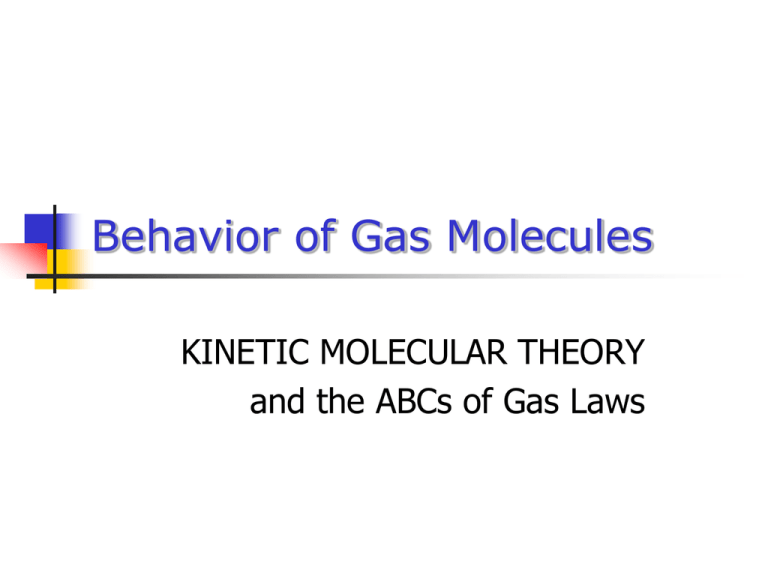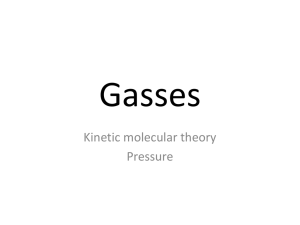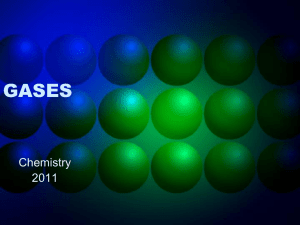
Behavior of Gas Molecules
KINETIC MOLECULAR THEORY
and the ABCs of Gas Laws
Essential Question
How do gases behave?
How do things like pressure,
temperature and volume affect gases?
Can we perform gas stoichiometry?
Launch activity
Take 5 minutes and fill in your chart:
What are some key characteristics of
solids, liquids and gases in regards to
spacing, potential of movement, and filling
a container?
Launch Activity
Use these questions to help you:
In which phase is there the least spacing?
In which phase is there the most potential
for movement?
Which phase(s) do(es) not have a definite
shape?
Launch activity
Solid
Spacing
Potential for
movement
Filling a
container
Liquid
Gases
Behavior of gases
How would you describe the behavior of
gases?
How do they differ from solids and liquids?
How do the molecules interact with each
other?
What happens if you keep filling a balloon?
Kinetic Molecular Theory
In 1860, Two scientists developed the
Kinetic Molecular Theory to explain the
behavior of gases and the relationship
among pressure, volume, temperature
and number of particles in a gas
sample.
The theory describes particle size,
motion and energy.
Kinetic Molecular Theory
It is called “kinetic” because the word
kinetic means “to move”.
Objects in motion have kinetic energy!
Quick check – what is potential energy
mean then?
Kinetic Molecular Theory
po·ten·tial en·er·gy
Noun
the energy possessed by virtue of
position relative to others, stresses
within itself, electric charge, and other
factors.
Particle Size
Gases consist of small particles separated
by empty space
The volume of the particles is so small in
comparison to the empty space, we say…
The volume or size of the individual
particles is negligible or equal to zero
All content by HST Educational Innovations © 2012. All rights reserved. Use of this material is invited with proper
attribution to the source.
Particle Motion
Gas particles are in constant, random
motion.
Gas particles move in straight line
(linear) motion until they collide with
the boundary or with other gas particles
Collision between gas particles are elastic
meaning no energy is lost.
Particles are assumed to NOT attract or
repel each other
Particle Energy
Since all of the molecules are in linear
motion, and therefore have a velocity, they
possess kinetic energy as defined by the
following equation:
Kinetic Energy = ½ (mass) (velocity)2
KE = ½ mv2
Temperature is simply a measure of the
average kinetic energy of the particles in a
sample.
Behavior of gases
In describing the behavior of gases, we talk
about
Temperature
Volume
Pressure
Before we can learn to solve Gas Law
problems, we must investigate these new
three vocabulary words
TEMPERATURE
Two scales to measure temperature:
Celsius:
0°C - temperature at which water freezes
100°C - temperature at which water turns to gas
Kelvin:
O K - Absolute Zero where all motion stops!
273 K - temperature at which water freezes
373 K - temperature at which water turns to gas
TEMPERATURE CONVERSION
From Celsius → Kelvin
Add 273 degrees
40ºC + 273 = 313K
From Kelvin → Celsius
Subtract 273 degrees
248 K - 273 = - 25ºC
For gas law problems, we MUST use Kelvin
in our calculations!
VOLUME
Volume is defined as the space that
matter occupies.
The base unit for volume is the liter
1 liter (L) = 1000 milliliters (mL)
1 milliliter (mL) = 1 cubic centimeter (cm3)
All content by HST Educational Innovations © 2012. All rights reserved. Use of this material is invited with proper
attribution to the source.
PRESSURE
Pressure is defined as the amount of force
applied to an area of matter:
Force
Pressure = ---------Area
Gas particles apply force on the container as
particles collide with the boundary
The SI unit for pressure is the pascal (Pa)
named after Blaise Pascal (1623-1662) a French
mathematician and philosopher.
Pressure
There are many traditional units for pressure:
Newton per meter squared (N/m2)
Pressure per square inch (psi) – used for your
tires!
Millimeters of mercury (mmHg) – from
barometers
Torr – defined as the same as mmHg
Bar – often used in pressure gauges
Atmospheres (atm)
Since there are so many units, we need to CONVERT
Pressure Conversions
Important pressure conversions
1 atm = 101.3kPa
1 atm = 760 mmHg
1 atm = 760 torr
1 kPa = 0.009869 atm
1 kPa = 7.501 mmHg
1 kPa = 7.501 torr
When doing these problems, be sure to
be consistent with your pressure units!
STANDARD TEMPERATURES &
PRESSURES (STP)
Sometimes a problem will state that the
reaction is occurring at STP or Standard
Temperature and Pressure.
You must know these values:
Standard Temperature:
Standard Pressure:
0ºC or 273K
1 atm
All content by HST Educational Innovations © 2012. All rights reserved. Use of this material is invited with proper
attribution to the source.
Let’s practice
1)
The pressure atop the world’s highest
mountain, Mt Everest is usually about
33.6 kPa. Convert this pressure to
atmospheres. How does this compare
to the pressure at sea level?
0.33 atm
Sea level is 1.0 atm
Let’s practice
2)
The atmospheric pressure in Denver,
Colorado is usually about 84 kPa.
What is this pressure in atm and torr
units?
0.83 atm
630.21 torr
Check for understanding
Work with a partner on completing:
Let’s practice problems
The Gas Laws
Demo #1
Demo: Take a syringe and depress it to see
how it feels. Now hold your finger over the
end and depress again.
What happens?
What relationship can we draw between
pressure and volume?
Demo #1
Now add a baby marshmallow to the
syringe. Place the syringe at the
farthest out positon. Cover with a cap
or your finger and push the syringe in
as far as you can. What happens to the
marshmallow? Release your finger or
the cap. What happens to the
marshmallow? Now try it the opposite
way!
Cartesian Diver Demo
A small amount of air is placed inside a
pipette and sealed and placed inside the
water bottle.
Squeezing the bottle (increases/decreases)
the pressure inside the bottle.
As a result, the volume of air
(increases/decreases) sending the diver
down! (Density = mass/volume)
Gas Law Relationships
What was the relationship between
Pressure
Volume
This is called Boyles Law
In order to do this experiment, what did we
not change – or hold constant?
Boyle’s Law
Examines the behavior of gas under the
condition of constant temperature
As the volume containing gas particles is
reduced, the particles are forced closer
together.
Can be written as: P1V1 = P2V2
1 stands for initial conditions
2 stands for final conditions
Boyles Law
As Pressure ↑, Volume ↓
As Pressure ↓, Volume ↑
Boyle’s Law is an Inverse
Relationship
Problems
Let’s try some problems.
Before solving each problem, predict if
your value will increase or decrease.
Then solve. Check your answer to see
if it agrees with your prediction!
Boyles Law problems
1.
The gas in a 600 mL balloon has a
pressure of 1.20 atm. If the
temperature remains constant, what
will be the pressure of the gas in the
balloon when it is compressed to 400
mL?
1.8 atm
Boyles Law problems
2. An oxygen container has a volume of
48 mL and a pressure of 420 kPa. What is
the volume of this gas when the pressure
is 105 kPa?
192 ml
Boyles Law problems
3. A tank of compressed CO2 has a
pressure of 850 psi and a volume of 150
mL. What is the volume of this gas when
the pressure is 45 psi?
2,833 ml
Demo #2
Balloon and the Flask (or Hot Air
Ballooning)
Place 10 mLs. or so of water in an
Erlenmeyer flask. Stretch an un-inflated
balloon over the mouth of the flask
(250 mL. flask).
Place the flask on hot plate
What happens to the balloon? Why?
Demo #2
Now, put the flask in a beaker of ice
and let it cool.
Now what does the balloon do? Why?
Gas Law relationships
What was the relationship between
Temperature
Volume
This is called Charles’ Law
In order to do this experiment, what did we
not change – or hold constant?
Charles’ Law
Examines the behavior of gas under the
condition of constant pressure
As the volume containing gas particles is
reduced, the particles must move slower to exert
the same force over a smaller surface area.
or
As temperature is decreased, the particles would
exert less force on the available surface area. In
order to restore the pressure lost through this
process, the surface area has to be reduced to
compensate.
Charles’ law
V1
V2
-------- = --------T1
T2
Temperature must be in
KELVINS!
Charles’ Law is a Direct
Relationship
Charles Law problems
1.
A 240 mL sample of argon gas at 270
K is cooled until the volume is 180 mL.
What is the new temperature?
202.5 K
Charles Law problems
2. A container of oxygen with a volume of
60 L is heated from 300 K to 400 K. What
is the new volume?
80 L
Charles Law problems
3. When a piston with a volume of 35 mL
is heated from 25ºC to 323ºC it expands.
Assuming the pressure on the piston
remains the same, determine the new
volume of the cylinder.
70 mL
Demo #3
Fill a shallow dish with water (colored
blue)
Place two candles in the dish with water
Cover with large beaker
Look at the level of the water before and
after the candles go out?
Gas Law Relationships
What was the relationship between
Temperature
Pressure
This is called Gay-Lussac’s Law
In order to do this experiment, what did we
not change – or hold constant?
Gay-Lussac’s Law
Examines the behavior of gas under the
condition of constant volume.
An increase in temperature increase the
collision frequency and energy, thus
increasing pressure.
Gay Lussac’s Law
P1
P2
-------- = --------T1
T2
Temperature must
be in KELVINS
Gay Lussac’s Law is a Direct
Relationship
Gay Lussac’s problems
1.
Determine the pressure change when
a constant volume of gas at 1.00 atm
is heated from 20.0 °C to 30.0 °C.
1.03 atm
Gay Lussac’s problems
2. A gas has a pressure of 0.370 atm at
50.0 °C. What is the pressure at standard
temperature?
0.31 atm
Gay Lussac’s problems
3. A gas has a pressure of 699.0 mm Hg
at 40.0 °C. What is the temperature at
standard pressure?
340 K
Teeter Totter
Is there a way we can easily remember
all of these relationships?
Demo #4
Demo: Boil water inside a soda can; invert
into a ice bath.
What happens?
What laws are we seeing in action?
Demo #4
According to Charles’ Law, as temperature inside the
can rapidly decreases, the volume this air will
proportionally reduce in volume.
According to Boyle’s Law, the water pressure on the
outside wall of the can will assist the trapped air in
reducing its volume by increasing the pressure and
crushing the can.
Together, the laws are “combined”!
COMBINED GAS LAW
Combines all three gas laws and allows
us to solve for changing conditions.
Combined Gas Law problems
1.
A canister containing air has a volume
of 85 cm3 and a pressure of 1.45 atm
when the temperature is 310 K. What
is the pressure when the volume is
increased to 180 cm3 and the
temperature is reduced to 280K?
0.62 atm
Combined Gas Law problems
2. Air is transferred from a 75 L tank
where the pressure is 125 psi and the
temperature is 288 K to a tire with a
volume of 6.1 L and a pressure of 25 psi.
What is the new temperature?
4.69 K
Combined Gas Law problems
3. A helium balloon at 28ºC has a volume
of 1.8 L and a pressure of 102 kPa. What
is the volume of the balloon when is rises
into the atmosphere where the pressure
is 85 kPa and the temperature is 4ºC?
1.99 L
Wrap it up with a video
http://ed.ted.com/lessons/1207-1-abennet-brianh264 (2:49)
If that doesn’t work:
https://www.youtube.com/watch?v=BY
9VGS2eXas
Let’s practice
Work on
1. Properties of Gases Questions
2. Mixed up Gas Law problems
For each problem – identify the gas law,
predict if the unknown value will increase
or decrease, and then solve.







